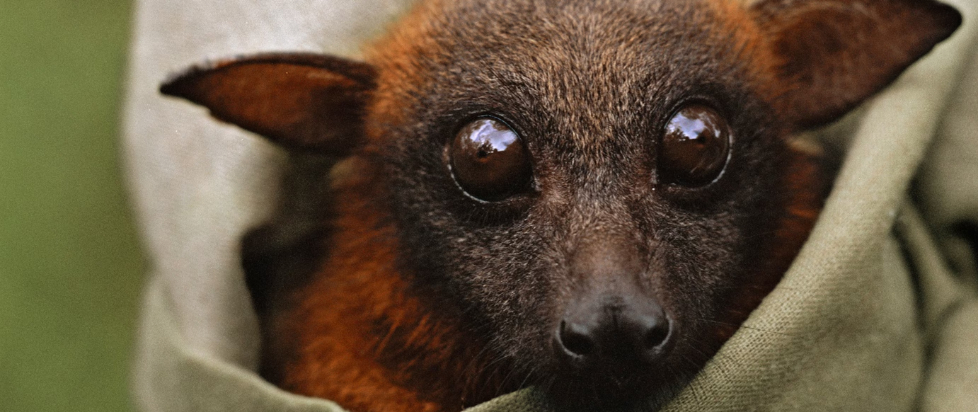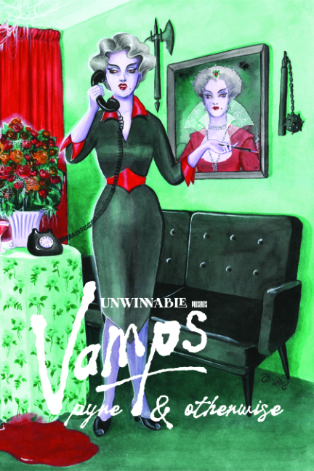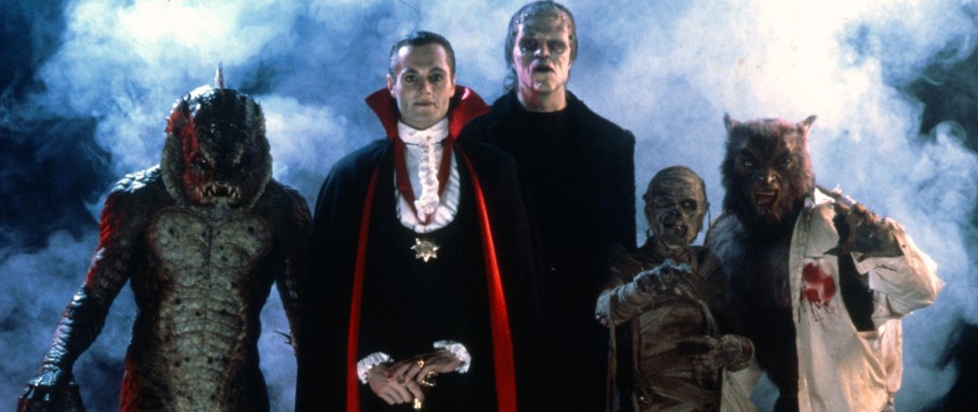
Where are the Giant Bats?

This column is a reprint from Unwinnable Monthly #168. If you like what you see, grab the magazine for less than ten dollars, or subscribe and get all future magazines for half price.
———
Thoughts about being something else.
———
Thou shalt be ravishing to the human eye. Thou shalt not be too inhuman. Thou shalt not be a beast like some mangy mongrels baying at the moon.
Feel free to throw out corrections and provide directions to media that features this – but so far, it certainly looks like vampires just don’t get as much shapeshifting action as werewolves, and that’s why they always tend to lose that competition in my mind. Who can compete with Bigby just transforming into a giant wolf to break Bloody Mary to pieces? Reverse of a werewolf he may be, having always been a giant wolf first that later takes on a human shape – but that’s an inverse that still leaves him in the werewolf circle as a very close relative or honorary member, and already more interesting than many vampires.
Not that vampires don’t have their own appeal. Some are neat. But generally, they could be more. Vampires could be a real contender with their obvious bat connection. But they haven’t seized their potential as much. To the point, why not more giant bat transformations to really counter werewolves? They do shift into their little bat forms for travel or a quick getaway, and that’s fun – but more could be done with it, there could be more variety.
And yet…perhaps that’s part of this vampiric reluctance?

i. Bats are adorable.
When thinking about real wolves and real bats…well, wolves also appear more threatening. Both animals can still get a bad reputation, and each has had their turn at being turned into fictional monsters for human purposes of horror. But that ghastly reputation seems particularly outsized for real-life bats. Like…for the most part, they’re just little guys. They really do kinda look like itty bitty flying mice, but even more appealing. With their compact bodies, they’re like chibi critters, but real.

Even the bigger ones are cute as heck. Check out the fruit bat or flying fox—almost alarmingly big, but their faces really do bear a similarity to particularly adorable foxes. They were perfect for starring in Janell Cannon’s picture book Stellaluna. And Falynn Koch’s educational Science Comics: Bats is a charmingly drawn piece of sequential art focused on the natural history of these animals, from the spectacled flying fox to the little brown bat. (Even their names can sound adorable.)
Now, wolves can be cute. They’re also bigger and can pose more of an immediate threat, or definitely look the part. (See 0:46 on this Nat Geo WILD video.) Bats, not so much. If their real animal link mostly leans toward wide-eyed and adorable, it’s kind of more reasonable that vampires tend to shy away from seriously transforming into them. Good for a swift escape, not so great for intimidation. Vampires apparently have a reputation to maintain.
ii. Bats can fly.
More on actual bats – they can fly. Actually fly. Not glide, but truly fly. Only mammal that can. Very cool.
But that must’ve been tough for live-action horror movies from the start, which have had an impact on vampires in general. Bela Lugosi’s Dracula may just well be what people think when they hear the word “vampire,” or they think of something that’s at least drawn some inspiration from Lugosi’s aesthetic and vibe. But Lugosi’s Dracula certainly didn’t pull off some insane shapeshifting illusion with special effects in 1931.
So perhaps early limitations of special effects and creatively thinking outside of the box played a role in keeping vampires generally more down-to-earth while stalking their prey.

iii. That human metaphor has its own draw.
Still, I can see a particular thing vampires can tend to go for, which I respect to some extent, even if I ultimately prefer something else. And it’s this:
The more human a monster looks, the more threatening they are. The more inviting, the more reason to be cautious.
Not like that’s the only theme that can crop up in a story with supernatural monsters. A theme like this certainly has its opposite in the visibly monstrous transformation, which the werewolf does approach more. Either the one with the most human visage is the one that’s the height of danger, or the most threatening opponent changes to a more visibly monstrous form. Your classic Final Fantasy villain going One-Winged Angel, if you will.
But back to vampires staying more human. Supernatural edges aside, they seem to often mimic predatory humans – and yes, particularly sexually predatory ones. “Vamp” is a word in Merriam-Webster with similar meaning. Those that blend in and seduce with romantic and sexual overtones, or both. It’s evident in a lot of episodes of Buffy the Vampire Slayer. It’s there in the very first scene of its series premiere, though with a gender-flip – the trope of the teen boy with one thing on his mind, and he’s drained dry by Darla, the vampiric woman playing herself up as an ingenue that had perhaps enticed him as an easy date. But after getting to know Darla later, one can imagine her simply using a different tactic to seduce and deceive her target.

And after finally digging into Dracula media for the first time by listening to the podcast adaptation Re: Dracula – yes, I don’t know much about what actually happens in the story of Dracula, or I hadn’t before – I can appreciate how the most iconic vampire of all tries to blend in as another human while sinking his proverbial claws into Jonathan Harker. There is a creeping dread while I listen to the claustrophobic-feeling interactions between Dracula and Jonathan even though I’ve been spoiled by pop culture history enough to know that the vampire probably wants to eat him. Or turn him. Or both.
And perhaps vampires leaning more toward human shapes also say something about humans themselves. Vampires as another metaphor for humans being the real monsters? I can buy it as a theme of the horror genre, one fictional message – though just a fragment, and not something that embodies the whole breadth and truth of humanity, but again, can make for a good horror story.
Also, more humanoid vampires can be a more palatable vision for genuine romance if The Shape of Water isn’t someone’s cup of tea. It doesn’t have to all be deception and hunting with vampires. For instance, it’s genuinely sweet and entertaining to watch Lisa and Dracula start bonding in the first episode of Castlevania.

iv. But giant bats can be cool.
Then there are some vampires or vampire-adjacent beings that dare to be different. Forget *bats being cute as all heck, forget winged flight maybe being hard to realize in a fictional live-action medium resulting in some pop cultural impact later down the line, forget the unique themes of human-shaped monsters – just bring out the giant winged beast shapeshifting.
(*Definitely have to diverge from real bats and get creative with making more warped designs, because as has been pointed out, real bats are adorable.)
Gary Oldman’s Dracula back in the nineties definitely dared, with multiple beast transformations and a distinctly nonhuman, ironically wolf-like set of blood-red armor. (Dracula in general has quite a few wolf connections in addition to the pop culture rivalry.) And the lack of flight was a complete nonissue – just a few impactful minutes of a towering twisted bat creature proved more than enough. The film crew worked within their limits and made it so that Dracula’s lack of flight doesn’t even ruffle the imagined universe they’ve crafted. It’s even more impressive as it was all created with practical effects.

And on the opposite end time-wise, there’s been something that’s interestingly more recent – The Last Voyage of the Demeter. Which I did not see because I actually don’t consider myself a horror fan even if I like some of the monsters like werewolves, the Xenomorph alien, the Cloverfield monster. I can just. Y’know. Look at pictures of them. Anyway, trailers and clips definitely indicate Demeter gives Dracula the bat wings and other twisted features without shrinking him to a real bat’s size, which is a plus.
Chronologically in between those two, there’s another Dracula getting a last-minute giant bat transformation in the grand finale battle with Hugh Jackman’s Van Helsing, who turns into a werewolf. I remember their shapeshifting clash fondly as easily my favorite part of the movie. I’m just a sucker for one-on-one monster fights. Also, gotta be honest – Van Helsing’s werewolf still looks cooler. But this Dracula gets points alongside his second-place ribbon for the literal winged metamorphosis.

An honorable mention to Man-Bat in Batman: The Animated Series, which went all out with deciding to use that particular rogue for their very first episode and pulling it off beautifully in 2D animation. Also an honorable mention for NOS-4-A2, who skyrockets to the upper reaches by virtue of him being a goddamned robot vampire. He feeds on other robots and electrical energy in general. He can seize control of those other robots. He can manipulate people’s technological armor and puppet them around as long as they’re trapped in their hacked suits. With the right bite under a certain irradiated moon, he can turn them into a robotic werewolf.
The shape of vampires could stretch and be more. But you know what? They could lean more into real-life bats being adorable too. And both would be good. Vampires can take on different shapes and vibes. Sky’s the limit for these strange bat fellows.
———
Alyssa Wejebe is a writer and editor specializing in the wide world of arts and entertainment. She has worked in pop culture journalism and in the localization of Japanese light novels. You can find her on Twitter @alyssawejebe.




